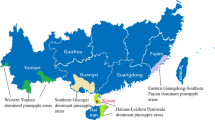Abstract
The potential impact of transgenic crops on community ecology will depend on the distribution and establishment of the new transgenic traits, on the sexual transfer of their new genes to the environment (Bartsch & Pohl-Orf, 1996) and on the potential ecological impact of the transgenic trait. Flowering and pollen dispersal is important for outcrossing of the genetically engineered trait. For a biennial plant, like the cultivars of Beta vulgaris L., overwintering is normally necessary to become generative and to produce pollen and seeds (Abe et al., 1997), which usually does not happen with sugar beet as a field crop harvested in autumn (Longden 1989). The starting point for the project was a transgenic sugar beet, Beta vulgaris L. subsp. vulgaris (Lange et al., 1998), with rhizomania and herbicide ( Basta®, Liberty®) resistance. Cold tolerance is one of the most important factors for survival of sugar beet in Central- and North-Europe. Among other ways, spreading of transgenic traits into weed beet (Boudry et al., 1993) or wild beet can occur if genetically engineered – biennial – plants survive the winter, flower in spring and spread their pollen. Field experiments were performed with transgenic breeding lines and their hybrids, transgenic and non-transgenic hybrids with Swiss chard and three conventional beet cultivars to evaluate winter survival rates at seven different field sites. We could show that survival of sugar beet – transgenic as well as conventional ones – in Germany and at the Dutch border is possible. Survival rates were well correlated with temperature data and were unexpectedly high. Differences between sugar beet hybrids and breeding lines could be detected but not within different breeding lines or hybrids. There were no differences detectable between transgenic and non-transgenic plants. The data are crucial for the risk assessment of the release of transgenic sugar beet and are the basis for further experiments towards outcrossing and establishment.
Similar content being viewed by others
References
Abe, J., G.-P. Guan & Y. Shimamoto, 1997. A gene complex for annual habit in sugar beet (Beta vulgaris L.). Euphytica 94: 129–135.
Anonymous, 1993. Report results from frost resistance trials with sugar beet (Beta vulgaris L.) transformed with glyphosate resistance genes. Reports to the National Agency for Environmental Protection, Denmark.
Barocka, K.H., 1985. Zucker-und Futterrüben. In: Lehrbuch der Pflanzenzüchtung landwirtschaftlicher Kulturformen. Bd. 2, Spezieller Teil, Paul Parey Verlag, Berlin-Hamburg, pp. 245–287.
Bartsch, D. & M. Pohl-Orf, 1996. Ecological aspects of transgenic sugar beet: Transfer and expression of herbicide resistance in hybrids with wild beets. Euphytica 91: 55–58.
Bartsch, D., M. Schmidt, M., Pohl-Orf, C. Haag & I. Schuphan, 1996. Competitiveness of transgenic sugar beet resistant to beet necrotic yellow vein virus and potential impact on wild beet populations. Molecular Ecology 5: 199–205.
Beck, E., G. Ludwig, E.A Auerswald, B. Reiss & H. Schaller, 1982. Nucleotid sequence and exact localization of the neomycin phosphotransferase gene from transposon Tn5. Gene 19: 327–336.
Boudry, P., M. Mörchen, P. Saumitou-Laprade, P.H. Vernet & H. Van Dijk, 1993. The origin and evolution of weed beets: consequences for the breeding and release of herbicide-resistant transgenic sugar beets. Theor Appl Genet 87: 471–478.
Doney, D.L., E.D. Whitney, J. Terry, L. Frese & P. Fitzgerald, 1990. The distribution and dispersal of Beta vulgaris L. ssp. maritima germplasm in England, Wales, and Ireland. Journal of Sugar Beet Research 27(1,2): 29–37.
Knapp, E., 1958. Beta-Rüben, Handbuch der Pflanzenzüchtung. In: H. Kappert & W. Rudorf (Eds), Bd 3 Züchtung der Knollen-und Wurzelfruchtarten. Parey Verlag, Berlin Hamburg, pp. 196–283.
Lange, W., W.A. Brandenburg & T.S.M. De Bock, 1998. Proposal for a new taxonomical classification of the cultivated forms of beet, Beta vulgaris L. In: L. Frese, L. Panella, H.M. Srivastava & W. Lange (Eds), International Beta Genetic Resources Network. A report on the 4th International Beta Genetic Resources Workshop and World Beta Network Conference held at the Aegean Agricultural Research Institute, Izmir, Turkey, 28 February-3 March, 1996. International Crop Network Series. 12. International Plant Genetic Resources Institute, Rome, 16–22.
Letschert, J.P.W., 1993. Beta section Beta, biogeographical patterns of variation, and taxonomy. Diss. Universiteit Wageningen 153 p.
Longden, P.C., 1989. Effects of increasing weed-beet density on sugar-beet yield and quality. Ann Appl Biol 114: 527–532.
Meulewater, F., P. Soetaert & J. van Emmelo, 1989. Structural analysis of the coat protein gene in different BNYVV Isolates. Medelingen Faculteit Land-bouwwetenschap Rijksuniversiteit Gent 54(2): 465–468.
Pohl-Orf, M., U. Brand, I. Schuphan & D. Bartsch, 1998. What makes a transgenic plant an invasive alien? Genetically modified sugar beet and their potential impact on populations of the wild beet Beta vulgaris subspec. maritima Arcang. In: U. Starfinger, K. Edwards, I. Kowarik & M. Williamson (Eds), Plant invasions: ecological mechanisms and human responses. Backhuys Publ., Leiden, pp. 235–243.
Rothmaler, W., 1990. Exkursionsflora von Deutschland. In: R. v. Schubert & W. Vent (Eds), Kritischer Band, 811 p.
Thompson, C.J., N.R. Mova, R. Tizard, R. Crameri, J.E. Davies, M. Lauwereys & J. Botterman, 1987. Characterization of the herbicide-resistance gene bar from Streptomyces hygroscopicus. EMBO Journal, 3: 2723–2730.
Wood, R.R., H.E. Brewbaker & H.L. Bush, 1950. Cold resistance in sugar beet. Amer Soc of Sugar Beet Technologists 6: 116–121.
Author information
Authors and Affiliations
Rights and permissions
About this article
Cite this article
Pohl-Orf, M., Brand, U., Drießen, S. et al. Overwintering of genetically modified sugar beet, Beta vulgaris L. subsp. vulgaris, as a source for dispersal of transgenic pollen. Euphytica 108, 181–186 (1999). https://doi.org/10.1023/A:1003680931766
Issue Date:
DOI: https://doi.org/10.1023/A:1003680931766




